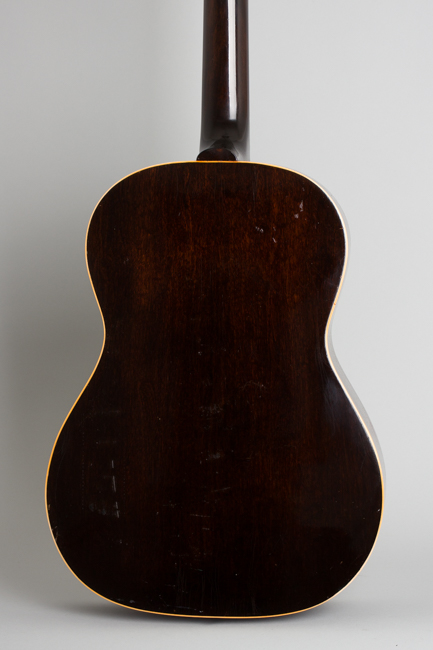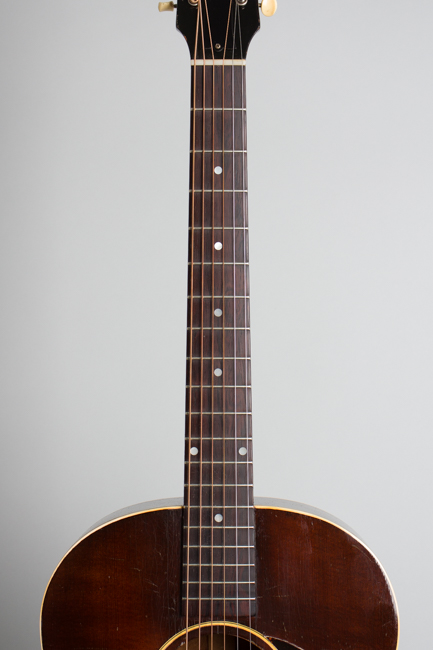Gibson LG-2 Flat Top Acoustic Guitar (1948)
This item has been sold.
Item # 11083
Prices subject to change without notice.
Gibson LG-2 Model Flat Top Acoustic Guitar (1948), made in Kalamazoo, Michigan, sunburst top, dark stained back and sides finish, mahogany back, sides and neck, spruce top, rosewood fingerboard, original black chipboard case.
This is a beautiful just post-WWII example of Gibson's most popular smaller body flat-top guitar model from the 1940s and '50s, the LG-2. It was the middle model of a three-instrument line with the externally identical but ladder-braced LG-1 below it and the natural-finish LG-3 above. Exact production figures from this period are lost, but in 1948-50 the LG-2 sold roughly 1000 instruments a year, with more than double that amount of LG-1's shipped. The first post-war ones like this are somewhat scarcer than later examples, suggesting they were built in smaller numbers as Gibson was just getting back up to speed after doing mostly war work for 4 years.
The 1946-48 flat tops have no serial or factory order numbers, so must be dated by features. This one appears to be a very early example with the block script "modern" logo that appeared in 1948, which is a decal not a silkscreen. Other typical features include a deep sunburst top finish, dark mahogany back and sides, small tortoise celluloid pickguard, small rectangle bridge and single-bound top and back. The headstock is tapered in depth, still with WWII pattern riveted-gear Kluson tuners fitted. The truss-rod equipped neck has a lovely round-backed "C" profile, substantial feeling but quite a bit slimmer than the thick wartime "baseball bat" style and very comfortable. This is a smooth, powerful sounding and versatile guitar; generally well preserved and an excellent example of Gibson's early post-war flat-top period.
Overall length is 39 1/2 in. (100.3 cm.), 14 3/8 in. (36.5 cm.) wide at lower bout, and 4 1/2 in. (11.4 cm.) in depth at side, taken at the end block. Scale length is 24 3/4 in. (629 mm.). Width of nut is 1 11/16 in. (43 mm.).
This is a very nice example overall, showing some play time since it was made before the Korean War well over 70 years old! The original lacquer is still shiny maintaining the original deep color to the sunburst and nice original patina overall. There is fairly heavy wear only to one spot, pick marks down to the wood on the lower soundhole rim. Other than this the face shows just small dings, scuffs, and other minor marks.
The back has a number of "strap burn" marks, the disruption of the surface caused by prolonged contact with a vinyl strap or something similar. Unfortunately this is not uncommon with clean guitars left in their cases for decades! In this case the impression of the strap can be seen in two long patterns on the back, which in some spots goes through the finish. There is also one spot on the join of the lower sides just around the endpin. While this cosmetic disturbance is visible it does not affect the guitar in any practical way.
The back of the neck is very clean with only a couple of small wear spots. The only visible repair is a small crack off the top edge of the pickguard, which is slightly shrunken but nice and flat not causing any further problems. There are no other cracks on the instrument. The neck has been expertly refretted with the correct style wire and neatly reset; the original bridge was previously lowered somewhat with a new saddle, but maintains decent height. This is a really excellent playing and sounding guitar, sweet and powerful sounding and far better preserved than most from the 1940's complete in the original heavy chipboard case. Excellent Condition.
This is a beautiful just post-WWII example of Gibson's most popular smaller body flat-top guitar model from the 1940s and '50s, the LG-2. It was the middle model of a three-instrument line with the externally identical but ladder-braced LG-1 below it and the natural-finish LG-3 above. Exact production figures from this period are lost, but in 1948-50 the LG-2 sold roughly 1000 instruments a year, with more than double that amount of LG-1's shipped. The first post-war ones like this are somewhat scarcer than later examples, suggesting they were built in smaller numbers as Gibson was just getting back up to speed after doing mostly war work for 4 years.
The 1946-48 flat tops have no serial or factory order numbers, so must be dated by features. This one appears to be a very early example with the block script "modern" logo that appeared in 1948, which is a decal not a silkscreen. Other typical features include a deep sunburst top finish, dark mahogany back and sides, small tortoise celluloid pickguard, small rectangle bridge and single-bound top and back. The headstock is tapered in depth, still with WWII pattern riveted-gear Kluson tuners fitted. The truss-rod equipped neck has a lovely round-backed "C" profile, substantial feeling but quite a bit slimmer than the thick wartime "baseball bat" style and very comfortable. This is a smooth, powerful sounding and versatile guitar; generally well preserved and an excellent example of Gibson's early post-war flat-top period.
Overall length is 39 1/2 in. (100.3 cm.), 14 3/8 in. (36.5 cm.) wide at lower bout, and 4 1/2 in. (11.4 cm.) in depth at side, taken at the end block. Scale length is 24 3/4 in. (629 mm.). Width of nut is 1 11/16 in. (43 mm.).
This is a very nice example overall, showing some play time since it was made before the Korean War well over 70 years old! The original lacquer is still shiny maintaining the original deep color to the sunburst and nice original patina overall. There is fairly heavy wear only to one spot, pick marks down to the wood on the lower soundhole rim. Other than this the face shows just small dings, scuffs, and other minor marks.
The back has a number of "strap burn" marks, the disruption of the surface caused by prolonged contact with a vinyl strap or something similar. Unfortunately this is not uncommon with clean guitars left in their cases for decades! In this case the impression of the strap can be seen in two long patterns on the back, which in some spots goes through the finish. There is also one spot on the join of the lower sides just around the endpin. While this cosmetic disturbance is visible it does not affect the guitar in any practical way.
The back of the neck is very clean with only a couple of small wear spots. The only visible repair is a small crack off the top edge of the pickguard, which is slightly shrunken but nice and flat not causing any further problems. There are no other cracks on the instrument. The neck has been expertly refretted with the correct style wire and neatly reset; the original bridge was previously lowered somewhat with a new saddle, but maintains decent height. This is a really excellent playing and sounding guitar, sweet and powerful sounding and far better preserved than most from the 1940's complete in the original heavy chipboard case. Excellent Condition.












